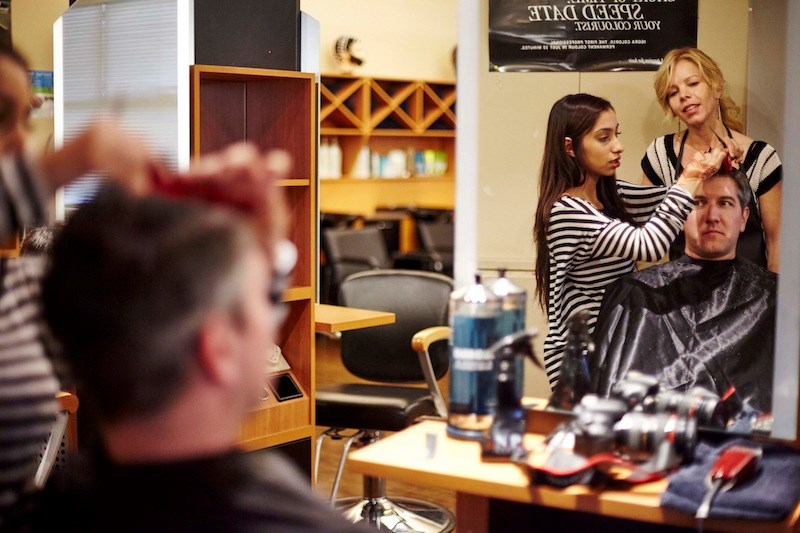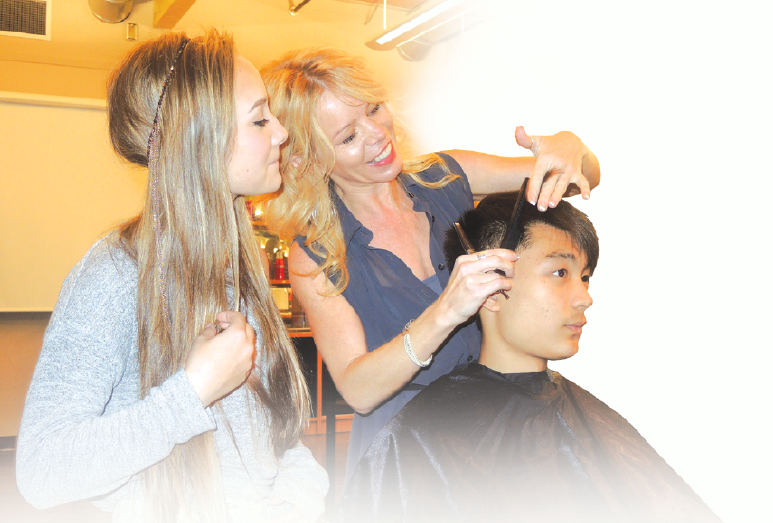The majority of Tara Balsdon’s friends have no clue what direction their lives might journey when they leave high school.
At 16 years old, it’s a safe bet they’re flirting between being submerged in social media and studying hard to bolster their grade-point average in a bid to clear a path into the right university.
Although Tara, a Grade 11 student at Hugh Boyd secondary, has one eye on the books, she’s also firmly focused on what and who she envisions being when she graduates in about 18 months’ time.
And when that day arrives, there’s a good chance the recent recruit into Richmond School District’s two-year ACE-IT Hairstylist program will be well on her way to realizing a career goal.
“Most of my friends have no idea what they want to do,” said Tara, who, after being surprised to hear her school runs a hair-styling program, now spends most of her classtime in the school’s “salon,” learning different haircuts, various braids and how to use styling irons.
“I’m really into hair and make-up and always have been. My mom was hesitant at first, but now she’s glad.
“She didn’t really know what the course was about and didn’t understand where it could lead to. But, knowing I was taking the course this fall, I spent the summer learning the trade in my mom’s best friend’s hair salon in Sechelt.”
Tara is one of 12 students currently enrolled in the hair-styling course in the district’s ACE-IT (Accelerated Credit Enrolment in Industry Training) program.
And she’s one of 53 Grade 11 and 12 teenagers devoting the lion’s share of their studies to other ACE-IT “trades,” including Auto Service Technician at McNair, Piping/Plumbing at Palmer and Professional Cook at Richmond Secondary.
B.C.’s Industry Training Authority (ITA) oversees the 100 ACE-IT programs across the province, billing it as a “chance to try out different trades and get a head start on an apprenticeship while you’re still in high school.”
The programs are deliberately targeted to engineer a fast-track into a life in the trade of the student’s choice, with successful candidates leapfrogging into the second level of continuing education once they’ve graduated from high school with a very valuable certificate in their back pocket.
In Tara’s case, where it could lead, according to her hair design instructor, Rhonda Stangeland, is a hair and/or make-up career in TV, film, advertising, business ownership and even teaching.
“The trades are a great way to get a head start in life and are a great way to have a successful career and earn good money,” said Stangeland, who’s been heading up the program for four years, with varying enrolment numbers.
“They can finish their apprenticeship here and then do another 2,000 hours out in the field, which equates to about a year and a half to two years.”

Program wins over parents
Convincing students of the hidden, and obvious, value of the district’s ACE-IT programs is one thing, said Stangeland — winning over the parents, is quite another.
“The thought is that it’s not an authentic program, or that it’s for incapable students,” said Stangeland.
“But this is very real and it can lead to all kinds of things. Parents should come along and spend some time here and see how students are flourishing.
“There is still a fear that their children won’t even leave with a high school diploma and that they won’t go on to become doctors and lawyers.
“They have a block off to help with other studies and they still have plenty of time for their core subjects.”
The program, added Stangeland, is in place of the likes of art, drama and physical education and she said students can still go to university after leaving high school, if they change their mind about the trades.
“They are still getting their academics. Many parents are concerned their kids will not get as high marks in the core subjects. But it can be done.
“Whatever you want to do, it can be done. They have nothing to lose by doing this program.”
Having the support of the community at large is also paramount for programs, such as the hair-styling, to work.
“It’s important that the salons in the city give them a helping hand and nurture these students,” said Stangeland, referring to the minimum, 125 industry apprenticeship hours each student must complete in order to graduate.
“They have to treat them the right way, as they are still very young. But, as much as they learn a lot in here, they have to get out in the real world as much as possible and that’s where we need the community’s help.
“As well as the class work, they are out doing work experience every day or on Saturdays. And a lot of the time, they come back with new ideas.”
Lots of hard work will pay off
Hygiene, tool maintenance, client service (getting over shyness, role-playing and body language), hair and scalp-care, cutting, styling, chemical waving and colouring are all crammed into the Hugh Boyd program.
“(The school salon) is a safe place to fail,” said Stangeland.
“I actually get excited when something goes wrong, as it gives me a great chance to teach and help them.”
Tara is equally enthused about the class.
“It’s so much better (than regular classes). I’m now doing what I actually want and love coming here, rather than having to be here,” said the teenager, who attends the hair-styling program every other day from 8:20 a.m. to 12:40 p.m., while also studying English, socials, science and planning.
“After this, I will maybe go and work in a salon for a year or two and complete my apprenticeship.
“But I’m interested in make-up artistry, I’ll maybe look at the Vancouver Film School, where there is a course specializing in this.”
The hair-styling student’s motivation is a pre-requisite for anyone enrolling in the program, according to Stangeland.
“They actually have to be interviewed by me before they are allowed into the program. It’s sort of like an informal job interview,” she said.
“Most of the students that enter this program have been thinking about it for a couple of years or so, so they are all pretty much on board.
“But their attendance is huge in this course; they simply have to be here, so they have to be self-motivated. We can’t be chasing people down the hallway.”
One drawback for the hair-styling program, is the cost of the tools they need.
“They are expensive at $1,100, but when you match that up with private school tuition of $15,000 to $20,000 a year and the fact there are no tuition fees here, then it’s very good value,” said Stangeland.
ACE-IT compliments the growing need for skilled workers
Dave Henderson, from the school district’s career programs department, said the trade programs in the city are “akin to completing the first year at technical school.
“It’s very much a head start and it’s all paid for, apart from the tools you will need.”
The biggest challenge, said Henderson, is credibility for and awareness of the programs.
“There have been plenty of stories about the need for a more skilled workforce in the provincial and national news, and this is one of the ways that Richmond is aligning with the new B.C. curriculum,” he said.
“We want to set our students up for success as they leave school and move into the workforce. Even with news stories, such as this, the message doesn’t seem to be resonating with the older parent generation, who are continuing to encourage...higher education and university as being the tried and trusted way to becoming successful.”



